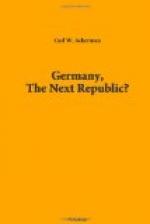On September 20th a convention of Socialists was held in Berlin for the purpose of uniting the Socialist party in support of the Chancellor. The whole country was watching the Socialist discussions because every one felt that the Socialist party represented the real opinion of the people. After several days of discussion all factional differences were patched up and the Socialists were ready to present a solid front when the fight came in the Reichstag on September 28th. On the 27th, Berlin hotels began to buzz with excitement over the possibilities of overthrowing the Chancellor. The fight was led by the National Liberals and Centre Party groups. It was proposed by Dr. Coerting, an industrial leader from Hannover, to move a vote of lack of confidence in the Chancellor. Coerting was supported by the big ammunition interests and by the von Tirpitz crowd. Before the Reichstag convened the Chancellor went to Great Headquarters for a final conference with the Kaiser and Field Marshal von Hindenburg. Before he left it looked as if the Chancellor would be overthrown. But when he returned he summoned the Reichstag leaders who were supporting him and several editors of Liberal newspapers. The Chancellor told them that von Hindenburg would support him. The next day editorials appeared in a number of newspapers, saying that von Hindenburg and the Chancellor were united in their ideas. This was the most successful strategic move the Chancellor had made, for the public had such great confidence in von Hindenburg that when it was learned that he was opposed to von Tirpitz the backbone of opposition to the Chancellor was broken.




